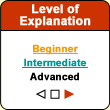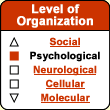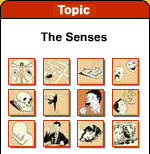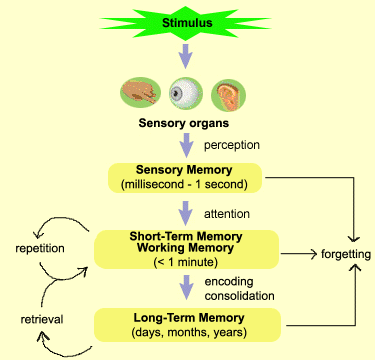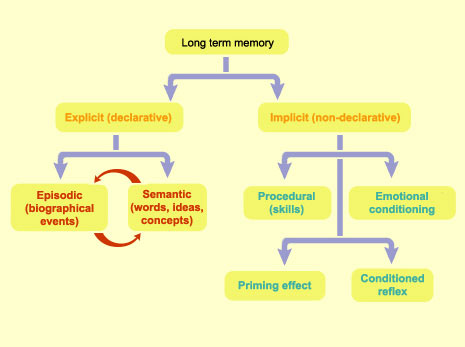|
|
| Funding for this site is provided by readers like you. | |
|
|
|
|
|||||
|
|
|||||||
|
|
|
|
|
|
Learning
How To Pique Curiosity When You Come Into a Room and Forget What You Were Going To Do There
|
|
Learning is a process that lets us retain acquired information, affective states, and impressions that can influence our behaviour. Learning is the main activity of the brain, in which this organ continuously modifies its own structure to better reflect the experiences that we have had. Learning can also be equated with encoding, the first step in the process of memorization. Its result - memory - is the persistence both of autobiographical data and of general knowledge. But memory is not entirely faithful. When you perceive an object, groups of neurons in different parts of your brain process the information about its shape, colour, smell, sound, and so on. Your brain then draws connections among these different groups of neurons, and these relationships constitute your perception of the object. Subsequently, whenever you want to remember the object, you must reconstruct these relationships. The parallel processing that your cortex does for this purpose, however, can alter your memory of the object. Also, in your brain's memory systems, isolated pieces of information are memorized less effectively than those associated with existing knowledge. The more associations between the new information and things that you already know, the better you will learn it. For example, you will have an easier time remembering that the entorhinal cortex is connected to the hippocampus via the dentate gyrus if you already have some basic knowledge of brain anatomy. Psychologists have identified a number of factors that can influence how effectively memory functions.
Forgetting is another important aspect of memorization phenomena. Forgetting lets you get rid of the tremendous amount of information that you process every day but that your brain decides it will not need in future.
|
| |||||||||||||||||||||||||||||||||||||||||||||||||||||||||||||||||||||||
When You Come Into a Room and Forget What You Were Going To Do There
|
Sensory memory is the memory that results from our perceptions automatically and generally disappears in less than a second. It includes two sub-systems: iconic memory of visual perceptions and echoic memory of auditory perceptions. Short-term memory depends on the attention paid to the elements of sensory memory. Short-term memory lets you retain a piece of information for less than a minute and retrieve it during this time. One typical example of its use is the task of repeating a list of items that has just been read to you, in their original order. In general, you can retain 5 to 9 items (or, as it is often put, 7±2 items) in short-term memory. Working memory is a more recent extension of the concept of short-term memory. As techniques for studying memory have become more refined, it has become increasingly apparent that the original conception of short-term memory as a mere temporary receptacle for long-term memory is too simplistic. In fact, it is becoming increasingly clear that there is no strict line of demarcation between memories and thoughts. In order to test some hypotheses that may provide a better understanding of this complex phenomenon, the concept of working memory has therefore been advanced.
Long-term memory includes both our memory of recent facts, which is often quite fragile, as well as our memory of older facts, which has become more consolidated. Long-term memory consists of three main processes that take place consecutively: encoding, storage, and retrieval (recall) of information. The purpose of encoding is to assign a meaning to the information to be memorized. For example, you might encode the word "lemon" as “fruit, roundish, yellow”. If you could not recall the word “lemon” spontaneously, then invoking one of the indexes that you used to encode it (such as “fruit”) should help you to retrieve it. How effectively you can retrieve information depends on how deeply you have encoded it, and hence on how well you have organized it in your memory. The process of encoding refers not only to the information being memorized, but also to its environmental, cognitive, and emotional context. Also, using mnemonic devices to associate ideas and images helps us to create links that facilitate encoding. (One classic example is the acrostic Every Good Boy Deserves Favour, for the musical notes on the lines of the treble clef.) But even when information has been well encoded, it can still be forgotten. Storage can be regarded as the active process of consolidation that makes memories less vulnerable to being forgotten. It is this consolidation that differentiates memories of recent facts from memories of older ones. The latter have been associated with a larger amount of pre-existing knowledge. Sleep, and in particular the rapid-eye-movement (REM) phase of sleep, along with reviewing (such as studying for exams) play a large role in consolidation. Lastly, retrieval (recall)
of memories, whether voluntary or not, involves active mechanisms that make use
of encoding indexes. In this process, information is temporarily copied from long-term
memory into working memory, so that it can be used there. The more a memory has
been encoded, elaborated, organized, and structured, the easier it will be to
retrieve. Retrieval of information encoded in long-term memory is traditionally divided into two categories: recall and recognition. Recall involves actively reconstructing the information, whereas recognition only requires a decision as to whether one thing among others has been encountered before. Recall is more difficult, because it requires the activation of all the neurons involved in the memory in question. In contrast, in recognition, even if a part of an object initially activates only a part of the neural network concerned, that may then suffice to activate the entire network.
|
Taking Photos To Remember Your Own Life Is There an Evolutionary Continuity between Spatial Navigation and Declarative Memory?
|
As the diagram below shows, long-term memory can be divided into explicit and implicit memory, and implicit memory can in turn be divided into various subtypes. But always bear in mind that in the actual workings of human memory, these various subsystems are interacting all the time. The interactions between episodic and semantic memory-two distinct forms of explicit memory-may offer the best example (see sidebar).
Episodic memory (sometimes called autobiographical memory) lets you remember events that you personally experienced at a specific time and place. It includes memories such as the meal you ate last night, or the name of an old classmate, or the date of some important public event. The most distinctive feature of episodic memory is that you see yourself as an actor in the events you remember. You therefore memorize not only the events themselves, but also the entire context surrounding them. Episodic memory is the kind most often affected by various forms of amnesia. Also, the emotional charge that you experience at the time of the events conditions the quality of your memorization of the episode. Semantic memory is the system that you use to store your knowledge of the world. It is a knowledge base that we all have and much of which we can access quickly and effortlessly. It includes our memory of the meanings of words–the kind of memory that lets us recall not only the names of the world’s great capitals, but also social customs, the functions of things, and their colour and odour. Semantic memory also includes our memory of the rules and concepts that let us construct a mental representation of the world without any immediate perceptions. Its content is thus abstract and relational and is associated with the meaning of verbal symbols. Semantic memory is independent of the spatial/temporal context in which it was acquired. Since it is a form of reference memory that contains information accumulated repeatedly throughout our lifetimes, semantic memory is usually spared when people suffer from amnesia, but it can be affected by some forms of dementia (see sidebar). |
| |
|
|
|
|
|
|
|
|

